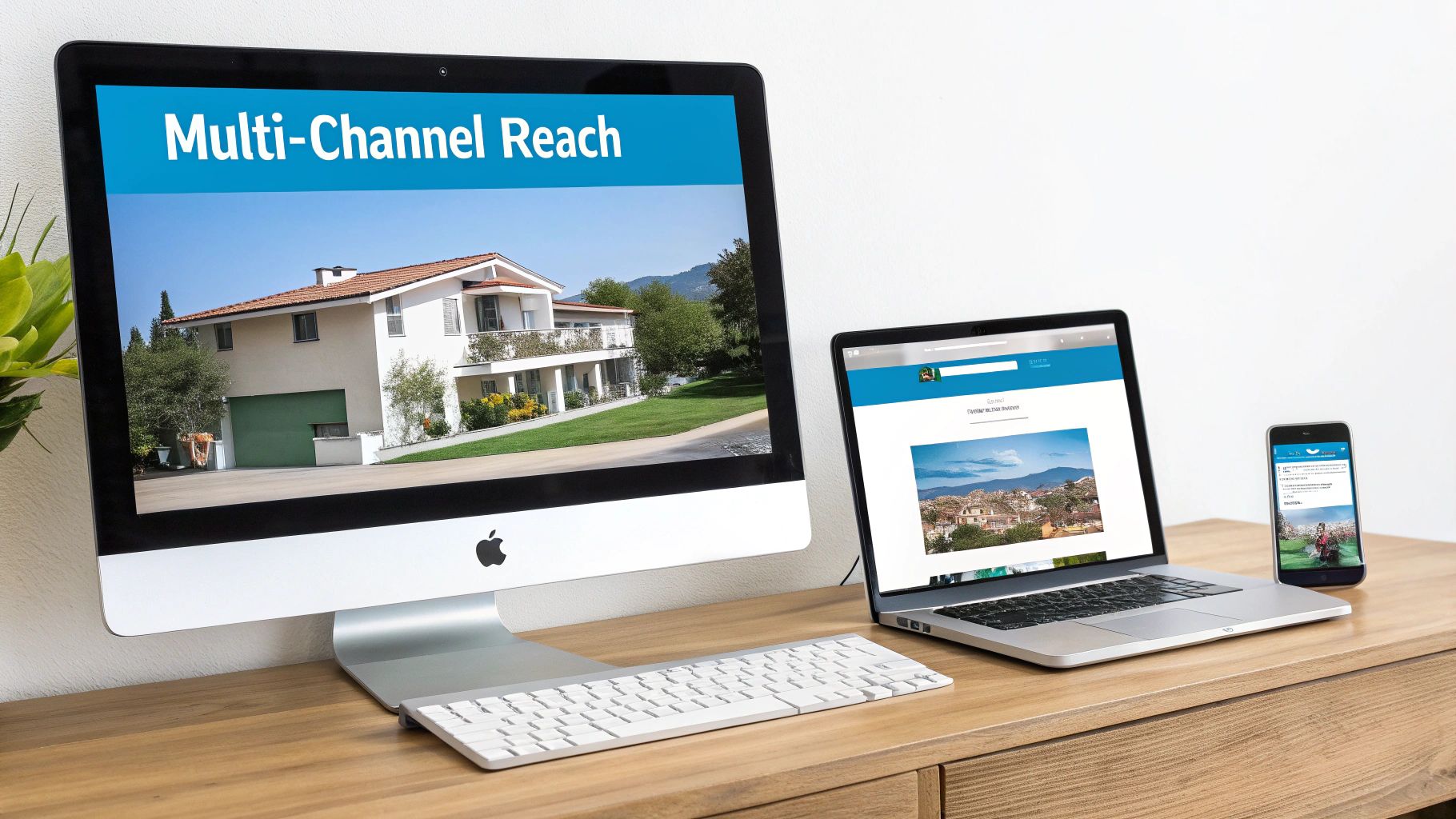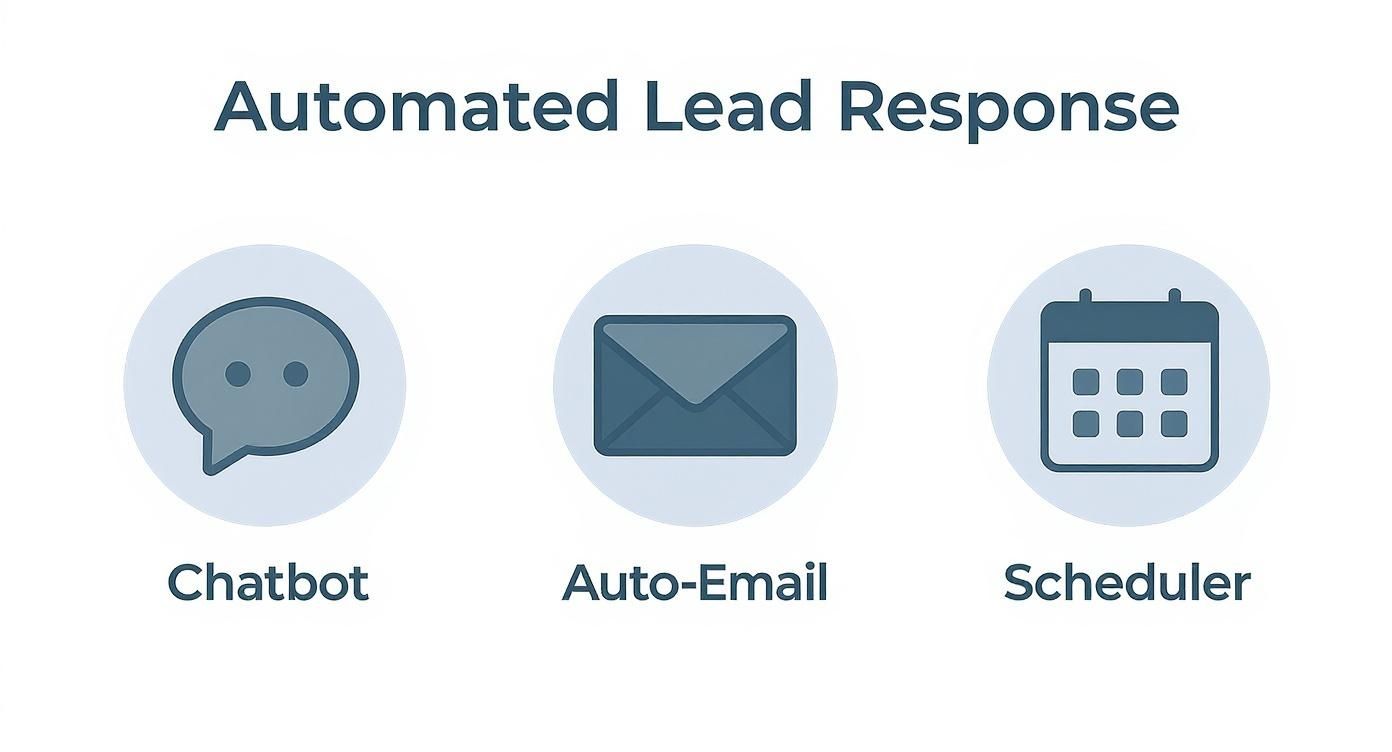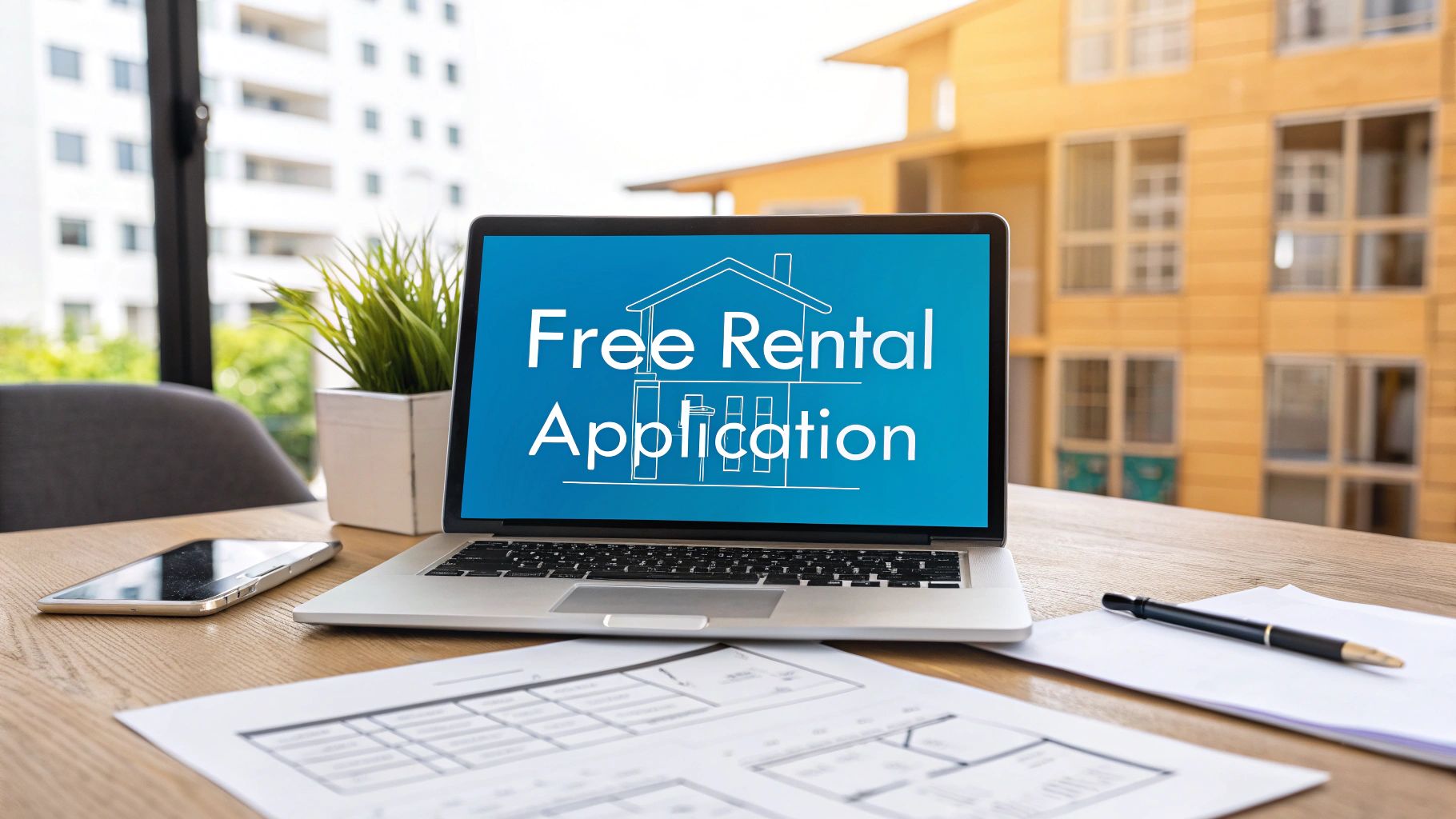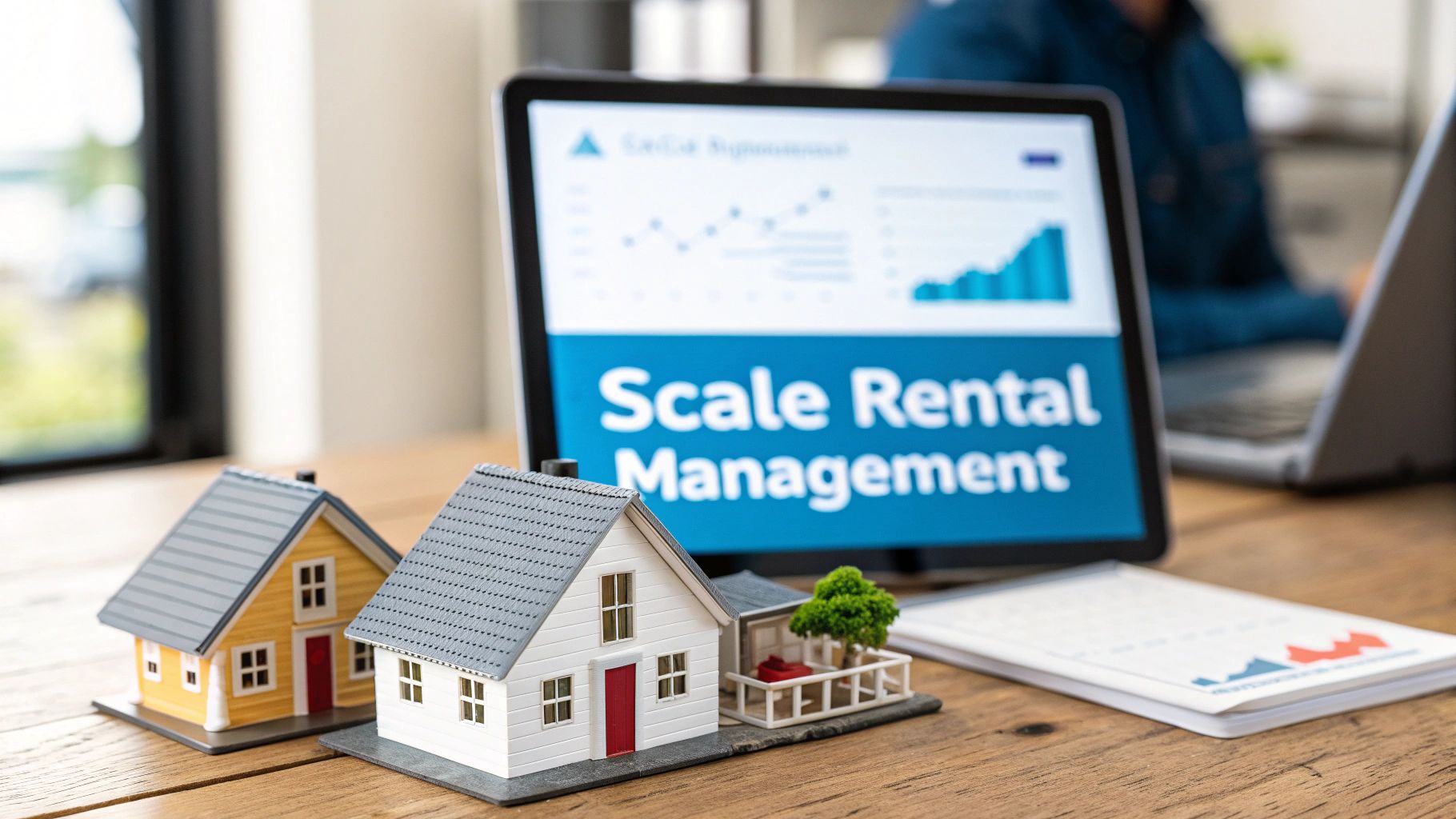For large-scale property management companies, advertising a rental property is a high-stakes race against the clock. Every day a unit sits empty, it directly erodes your portfolio's Net Operating Income (NOI). Winning this race requires more than just a listing; it demands an enterprise-grade framework that transforms advertising from a manual task into a scalable, automated revenue driver.
The goal is always the same: attract a high volume of qualified leads and convert them into signed leases at maximum velocity, minimizing vacancy loss and optimizing cost per door across your entire portfolio.
Crafting Rental Listings That Convert at Scale

When you're managing a large portfolio, a rental ad isn't just a flyer—it's your most powerful weapon against high Days on Market (DOM). Every component of that ad must be engineered to drive a single action: converting a prospect's interest into a scheduled tour.
For property managers juggling hundreds or thousands of units across multiple markets, a generic "good enough" template is a slow bleed on revenue. You need a system—a data-backed, scalable framework that can be deployed across every property to generate consistent, high-quality results and accelerate your speed-to-lease.
This means looking beyond basic bed/bath counts to highlight specific, revenue-driving amenities and lifestyle perks that justify rental rates and create urgency in a competitive market.
Headline and Description Optimization
Your headline is the first filter in the leasing funnel. Instead of the undifferentiated "2 Bed, 2 Bath Apartment for Rent," your headline must grab the attention of high-intent prospects.
A more powerful, data-driven approach calls out a key feature that targets a valuable tenant segment. For example, "Spacious 2BR with Pet Spa & WFH Nook - Tour Today!" instantly resonates with two critical demographics: remote workers and pet owners, significantly boosting click-through rates.
The description must support the headline with a clear, scannable structure that justifies the rent. This simple, scalable formula works consistently:
- The Hook: A single, compelling sentence selling the primary benefit of living there.
- The Features: A bulleted list of the top 5-7 revenue-driving amenities (e.g., in-unit laundry, stainless steel appliances, private balcony, smart home technology).
- The Neighborhood: A brief snapshot of proximity to major employers, transit, or desirable local spots.
- The Ask: A clear, direct call-to-action that reduces friction. "Click here to schedule your self-guided tour instantly" is far more effective than a vague "Contact us for details."
The Financial Impact of Visual Assets
For enterprise property managers, professional photography and virtual tours are not marketing expenses; they are core operational investments with a clear ROI. Poor visuals actively increase DOM, directly costing your portfolio revenue every single month.
To get your ads noticed, you need a solid foundation. This isn't just a checklist; it's a strategic framework for turning listings into leases faster, directly impacting your bottom line.
Core Components of a High-Performing Rental Ad
A breakdown of the essential elements that every rental advertisement must include to maximize lead generation and reduce days on market for large portfolios.
By systematically optimizing each component, you build a repeatable process that converts listings into signed leases faster, directly impacting NOI across the entire portfolio.
The numbers don't lie: high-quality visuals have a direct and measurable impact on reducing vacancy. Listings with professional photos can lease 32% faster on average. That speed is a game-changer for large portfolios, where shaving just a few days off the DOM for each unit adds up to significant revenue recovery.
Virtual staging, which costs a fraction of physical staging, helps properties lease an incredible 75% faster. It helps prospects visualize the space as their own, creating an emotional connection that drives tour bookings.
For a deeper dive into creating visuals that drive leasing velocity, our guide on effective rental marketing photos is an essential resource. For any serious operator focused on optimizing cost per door, investing in a standardized, top-tier photography and virtual tour process for every unit is non-negotiable.
Building a Multi-Channel Rental Advertising Strategy

When managing hundreds or thousands of units, posting a listing on a single website is a recipe for high vacancy rates and missed revenue targets. To protect your bottom line, you must be everywhere qualified renters are looking. This requires a true multi-channel distribution strategy that maximizes exposure without overwhelming your operations team.
The foundation is listing syndication. Instead of manually uploading data to Zillow, Apartments.com, and others, your tech stack must blast listings across the entire rental network simultaneously. This isn't just a time-saver; it ensures brand and data consistency across your portfolio, which is critical for operating at scale.
Expanding Beyond Traditional Listing Sites
Syndication covers the major platforms, but to truly dominate a market, you must tap into channels where high-intent renters are already active. Social media and strategic local outreach are your secret weapons for driving down Days on Market (DOM).
Facebook Marketplace, for example, is a goldmine with a massive, built-in local audience. Its ad platform allows for hyper-specific targeting by income, location, and life events, attracting higher-quality leads and boosting lead-to-tour conversion rates.
For maximum impact, integrate paid advertising like targeted Google Ads campaigns. This captures prospects at the peak of their intent—the exact moment they search for rentals in your area.
Automating for Scalability and Speed
The end goal is a fully automated distribution machine. Your property management software (PMS) or leasing platform must have robust API integrations that sync with all advertising channels. When a unit's status or price changes, that update must propagate everywhere—instantly.
This level of automation is how you shrink leasing timelines across a large portfolio. It eliminates the human error and delays that lead to lost leads and costly vacancy days. For a deeper look at this process, explore our resources on property management marketing automation.
A multi-channel strategy is fundamentally about speed-to-lease. By casting a wide, automated net, you create a predictable pipeline of qualified leads. A full pipeline means you fill vacancies faster, converting vacancy loss into realized revenue. For any large portfolio serious about reducing DOM, this approach isn't optional—it's essential.
Using Market Data to Optimize Pricing and Performance
Setting rental prices across a large portfolio based on gut feel is a direct path to revenue loss. To maximize returns, your pricing and advertising strategy must be driven by hard data. For property managers focused on operational efficiency and cost-per-door metrics, market analytics are non-negotiable.
This allows you to benchmark everything: rental rates, security deposits, concessions, and pet fees against real-time competitor data. This is how you ensure your properties are priced for velocity, which directly impacts your Days on Market (DOM) and portfolio NOI.
Conducting a Scalable Competitive Analysis
For large portfolios, a meaningful competitive analysis is a systematic, repeatable process, not a one-off task. It requires tracking several key data points across your markets:
- Price Per Square Foot: The ultimate equalizer, providing a more accurate comparison than flat rental rates across varied unit types.
- Amenity Packages: Document competitor offerings like in-unit laundry, smart home tech, and dedicated parking. These features directly influence achievable rent.
- Concessions and Specials: Track offers like "one month free" or waived fees to position your own incentives strategically, avoiding unnecessary revenue giveaways.
- DOM for Comparable Units: If similar local properties are leasing faster, it's a critical red flag that your pricing or marketing is misaligned.
Implementing Dynamic Pricing Strategies
Leading property management companies are adopting dynamic pricing models similar to the airline and hotel industries. These systems use algorithms to adjust rental rates based on real-time supply and demand, seasonality, and even lead volume for a specific unit. This ensures you're never underpriced in peak season or over-priced during a slow month.
The impact is significant. Dynamic pricing algorithms can boost revenue per available rental (RevPAR) by as much as 10.7%. Data also shows that in-demand amenities can command a premium; for example, being pet-friendly can add an average of $17.41 to a daily rate. You can explore more data on these trends and other vacation rental statistics to understand the full financial impact.
Key Takeaway: Static pricing is obsolete. By leveraging property management software with dynamic pricing capabilities, you can automate rate adjustments across your portfolio, ensuring every unit is priced for optimal leasing velocity and maximum revenue.
Focusing on Advertising Metrics That Matter
To optimize your advertising budget, you must track performance with ruthless efficiency. It's not about impressions; it's about the cost to acquire a rent-paying tenant.
For every channel, you should be laser-focused on these critical metrics:
- Cost Per Lead (CPL): The spend required to generate one inquiry.
- Cost Per Tour: The investment needed to get a qualified prospect to view the property.
- Cost Per Application: The expense to convert a prospect into a serious applicant.
- Cost Per Lease (CPL): The bottom-line metric—the total ad spend required to secure a signed lease.
Tracking these KPIs allows you to reallocate budget from underperforming channels to high-ROI platforms, directly improving your cost-per-door efficiency and filling vacancies faster.
Automating Lead Response to Win the Race to Lease
In large-scale property management, the time between a prospect's inquiry and your response is a critical battleground. Every minute of delay increases the odds they will schedule a tour with a competitor.
For portfolios with hundreds or thousands of units, manual follow-up is not just inefficient—it's a direct drag on revenue. Speed-to-lead is your most powerful competitive advantage.
The solution is an automated system that engages every lead instantly, 24/7. A prospect inquiring at 10 PM on a Friday must receive an immediate, professional response that guides them to the next step. This single action can dramatically improve your lead-to-tour conversion rate.
Implementing Instant Engagement Workflows
To win the race to lease, you must eliminate human delay at the first point of contact. This requires a seamless, automated workflow that captures, qualifies, and drives leads toward a scheduled tour without manual intervention.
This is a non-negotiable for minimizing vacancy costs. A rapid, automated response system ensures no lead goes cold, which is critical for slashing your Days on Market (DOM) portfolio-wide. The essential components include:
- AI-Powered Chatbots: Field common questions, pre-qualify prospects against your criteria (income, move-in date, pets), and funnel them directly to your scheduling platform.
- Automated Email & SMS Responders: Triggered instantly upon inquiry, these provide acknowledgment and a direct link for prospects to book a self-service tour.
- Self-Service Tour Scheduling: Empowering prospects to book a showing on their own time eliminates the back-and-forth that creates bottlenecks for leasing teams managing large portfolios.
A slow response is the fastest way to lose a qualified lead. Automating the initial touchpoint ensures a consistent, professional experience and a clear path to a tour. This plugs lead leaks and directly improves your speed-to-lease metrics.
The Impact of AI on Leasing Velocity
Modern PropTech goes beyond simple auto-replies; it offers intelligent automation. An advanced system, like an AI leasing assistant, doesn't just respond—it learns. It can analyze inquiry data to flag hot leads for immediate follow-up or suggest alternative available properties if a prospect's first choice is no longer available.
By integrating smart technology, you transform your leasing process from a reactive, manual chore into a proactive, automated engine for growth.
To see this in action, learn more about the benefits of using an AI leasing assistant and how it streamlines these critical workflows. Adopting this technology is fundamental to reducing operational overhead and maximizing revenue in a competitive rental market.
Measuring Your Advertising ROI to Maximize Profit
Scattering ad spend across multiple channels without rigorous tracking is a fast way to drain your budget. In a competitive market, every dollar must be accountable, especially when managing a large portfolio. It's time to move beyond tracking expenses and start calculating the real return on investment (ROI) for every advertising channel.
For operations directors and portfolio managers, this is about financial performance. The core question is: which channels deliver qualified tenants at the lowest Cost Per Acquisition (CPA)? Tracking this metric empowers you to shift budget to proven platforms and cut underperformers.
This is where automation becomes a game-changer. The right tools can turn ad spend into signed leases by making sure no lead falls through the cracks.

From chatbots that qualify leads instantly to schedulers that book tours 24/7, an integrated tech stack ensures your marketing dollars are converted into tangible results.
Conducting a DOM Cost Analysis
Beyond CPA, the most powerful tool for proving advertising ROI is a Days on Market (DOM) cost analysis. This calculation transforms the abstract concept of vacancy into a hard dollar figure that commands attention, showing precisely how much revenue is lost for every day a unit is empty.
Here’s the simple framework:
- Calculate Daily Rent: (Monthly Rent) / (Days in Month). For a $2,100/month unit, that’s $70 per day.
- Calculate Total Vacancy Cost: (Daily Rent) x (Total DOM). If the unit was vacant for 21 days, that’s a $1,470 revenue loss.
- Scale Across the Portfolio: Multiply that loss by the number of vacant units. The financial impact becomes substantial, fast.
This analysis is your silver bullet for justifying technology investments. When you can demonstrate that a faster leasing platform will reduce average DOM by five days, you can show precisely how much revenue that improvement will recapture for the portfolio.
This example for a 1,000-unit portfolio illustrates the massive financial impact of even a small DOM reduction.
DOM Cost Impact Analysis (Example Portfolio)
As the table shows, cutting just five days from the average vacancy period translates into hundreds of thousands of dollars in recovered annual revenue.
Financial rigor is more critical than ever. In 2024, the U.S. rental market saw over 600,000 new multifamily units come online—a 65% increase from 2022. With supply up and rent growth slowing to just 1.0%, your advertising must work smarter to fill units at target rates.
Proving the Financial Impact to Stakeholders
Ultimately, measuring advertising ROI is about linking leasing strategy directly to the company's financial health. When you can present clear data on CPA and the real cost of vacancies, you build an undeniable business case for adopting tools that shorten the leasing cycle.
This data-driven approach transforms the conversation. Advertising is no longer a "cost center"; it's a critical driver of revenue. To ensure your strategies are delivering, it’s worth diving deeper into how to effectively measure your advertising effectiveness. This is how you prove the value of your leasing operations and secure the resources needed to scale efficiently.
Got Questions About Rental Advertising? We've Got Answers.
Even with the best strategy, managing a large rental portfolio presents unique scalability challenges. Let's address common questions from operations directors and portfolio managers, focusing on technology, standardization, and ROI.
How Do We Standardize Ad Quality Across a Dispersed Portfolio?
Consistency at scale requires a repeatable system. Develop a "Listing Launch Kit" for each property type. This plug-and-play blueprint should include:
- A template for benefit-driven descriptions.
- A mandatory shot list for photographers.
- Clear specifications for virtual tours.
Implement a central review process using a project management tool where a regional manager or marketing lead approves every listing against a quality checklist before it goes live. This ensures every ad meets brand standards and is optimized to convert.
The goal is to eliminate guesswork. A standardized, data-backed process turns every listing into a high-performing asset, systematically reducing your Days on Market (DOM) across the entire portfolio.
What’s the Best Way to Track Lead Sources Without Manual Entry?
Manual lead tracking is slow, error-prone, and a surefire way to misallocate ad spend. The only scalable solution is to integrate your leasing CRM or property management software directly with listing sites via API.
This connection automatically tags every lead from sources like Zillow, Facebook Marketplace, or your website. You gain clean, reliable data to calculate your true cost per acquisition (CPA) for every channel. This is how you optimize your cost per door efficiency and stop investing in underperforming platforms.
How Can We Justify a Bigger Ad Budget to Stakeholders?
You must speak their language: revenue and ROI. Stop asking for a "bigger marketing budget" and start presenting a clear DOM cost analysis.
Calculate the exact dollar amount lost for every day a unit sits vacant and frame your request as an investment to stop that revenue leak.
For example, show them how investing in an automated showing platform will slash average DOM by five days. Then, do the math: multiply that five-day rent savings across all units in your portfolio. When you can prove that a $50,000 investment will recapture $350,000 in lost rent, the conversation shifts from an expense to a clear financial win.
Ready to accelerate your entire leasing process, from first click to signed lease? Showdigs is built for this. Our AI-backed leasing automation platform is designed for large, distributed portfolios to slash DOM and maximize lead-to-tour conversions.
Schedule a demo today to see how you can systematize your showings and drive significant financial performance for your portfolio.






